What to Know About Raising a Dog in the City
[ad_1]
Raising a Dog in the City by Nicole McCray |Published 02-12-2021
Some people think having a dog in the city is a bad idea, believing that they’re stuck in a tiny apartment all day. But that’s not the case at all. Most city dogs spend just as much time outdoors (maybe more) as rural dogs do.
That’s because people who live in urban areas walk everywhere, and they tend to bring their pups with them. From walks in the park to social outings and lunch at sidewalk cafes, small dogs are a common and welcome fixture of the downtown lifestyle.
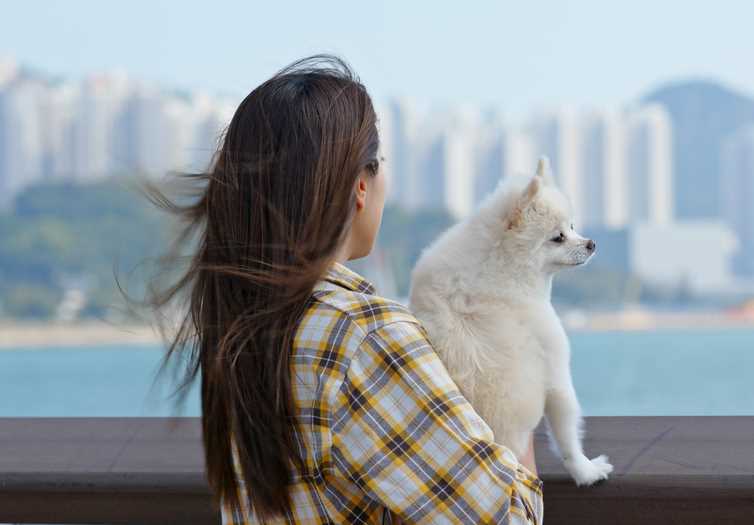 Raising a Dog in the City
Raising a Dog in the CityOf course, raising a dog in an urban environment isn’t quite the same as raising one in the suburbs. From potty training to exercise, and health care to socialization, here’s what city-dwelling pet parents need to know about raising a dog in a downtown area.
Raising a Dog in the City: Tips
Stay on Top of Vaccines and Parasite Control
Dog-friendly outdoor spaces in the city are usually shared by many pets and people. According to doctors at Bond Vet Animal Hospital in NYC, “It’s especially important to stay on top of vaccinations and parasite control when you have many animals sharing the same common space.”
Intestinal parasites, fleas, and ticks can all be transmitted from dog to dog. City dogs should be kept on monthly parasite prevention all year round to protect them from these issues.
Staying current on vaccinations also protects your dog from many transmittable illnesses, including rabies, kennel cough, and doggie flu. Keeping your dog’s vaccinations up to date also protects you if someone ever accuses your dog of biting them.
You don’t have to keep your proof of current vaccinations with you at all times, but your pup should have his rabies tag and an up-to-date ID tag on his collar whenever you leave your apartment.
Dog Proof Your Apartment
Before you bring home your new dog or puppy, take the time to dog-proof your apartment just like you would if you had a baby or toddler. Get down on a dog’s level, look for anything potentially hazardous and move it out of reach.
Chords, houseplants, cables, and remote controls can all be very tempting to a bored dog, and chewing on them could be dangerous. Of course, you’ll also want to make sure your valuable belongings are out of reach too.
Provide your new pooch with a safe play area and plenty of toys to keep him busy. Keep in mind that hard toys will make a lot of noise when your pup tosses them around, so plush toys are more neighbor-friendly.
Your puppy’s toenails can be damaging to certain types of flooring. You might want to designate a specific play area with a mat or area rug to protect the floor and soften any noise your pup makes when playing.
Potty Training Your Small Dog in the Big City
Potty training a small dog in the city does come with some challenges, but dogs can adapt easily with proper training.
One of the biggest challenges is that dogs don’t naturally like to go to the bathroom on a hard surface, such as a concrete sidewalk. If you don’t have access to a green space, it may take your dog some time to adjust.
Another challenge is getting your dog down the elevator, through the lobby, and out to an appropriate potty area before he has an accident indoors. It’s even worse when everyone from the doorman to the neighbor wants to say hello and pet your pooch. This is especially challenging for a puppy.
But there are some strategies you can utilize that will be really helpful. First, follow a strict potty schedule and take your pup to the same potty spot every time you go out. Knowing when to expect a potty break and exactly where to go will help your pup learn to hold it until you get to the designated area.
You might also consider trying some in-house or balcony potty solutions for your pup, such as puppy pads or an indoor potty box. This can be especially helpful for young puppies, senior dogs, or whenever your trip to an appropriate potty place is very long or inconvenient.
Keeping your pup on a consistent feeding schedule is also key for potty training. It’s best to give him his meals about 20 minutes before you’re ready to head outside. That way, his body will get used to the schedule and he’ll be ready to go to the bathroom when you get out there.
“Curb” Your Dog
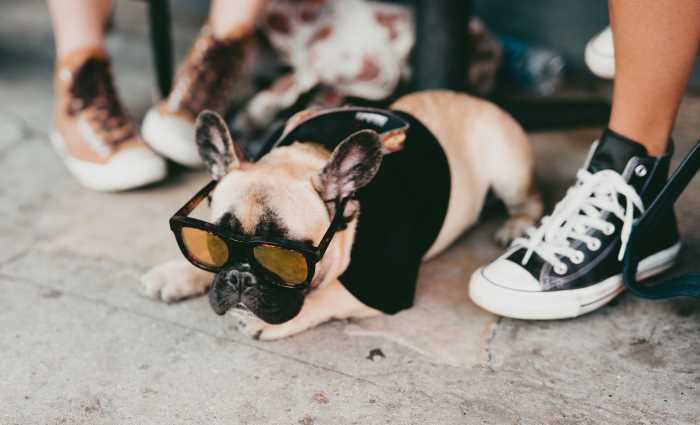 When raising a dog in the city, it’s important to “curb” him out of courtesy to other pedestrians.
When raising a dog in the city, it’s important to “curb” him out of courtesy to other pedestrians.Curbing your dog is really about being considerate of others so that no one accidentally steps in your dog’s pee or poo. It simply means encouraging your dog to potty at the very edge of the sidewalk, or just off the sidewalk if there’s a safe place.
To teach this behavior, whenever he has to go, gently pull him to the curb. Dogs are creatures of habit, so they’ll figure out what they’re supposed to do pretty quickly, especially if you’re consistent about guiding them.
Of course, you’ll still need to bring along a bag for the poo. Leaving your dog’s waste on the sidewalk is unsanitary. It can also lead to the transmission of illness or parasites like hookworms and roundworms.
Watch the Sidewalk in Front of You
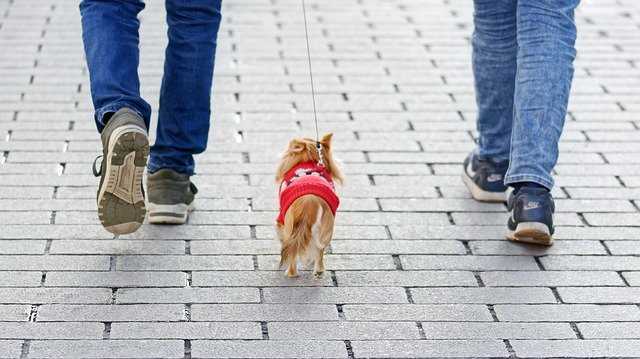
One of the most important things to think about when walking your dog in the city is watching the sidewalk in front of you. There can be all kinds of goodies on the sidewalk, from chicken bones to wrappers. It will all smell amazing to your pup, but you certainly don’t want him eating it.
To ensure that your pooch isn’t eating anything he shouldn’t, have him walk just a little bit in front of you so that you can keep an eye on him and the sidewalk.
Teach Your Dog Basic Commands
The experts at the ASPCA recommend that every city dog learns at least four basic obedience commands. They are “come,” “heel,” “leave-it,” and “sit/stay.”
It’s also a good idea to train your dog to stop, sit, and wait when you stop. If you’re at a busy intersection, you want your dog to stay in the sit position until you give him permission to start moving again.
More about Basic Dog Commands
Give Your Dog a Space of His Own
Dogs appreciate having their own cozy space to relax in, which is why many experts recommend crate training dogs and puppies. A crate or playpen with a comfy bed and a few favorite toys make a perfect doggy den.
If your dog loves to watch what’s going on around him, consider placing his crate near a window. That way he can occupy himself by watching all the interesting things going on outside. Just be sure the sun won’t come in the window and cause him to overheat, especially if he will be confined to the space when you’re not home.
Or, if your dog prefers peace and quiet, set up his crate away from the windows. A cozy spot next to your bed could be a great spot. That way he’ll have the comfort of your familiar scent even when you’re not at home.
Consider Hiring a Dog Walker
If you’re out of the house all day for work, you might want to consider hiring a dog walker. A walker will stop by in the middle of the day to give your dog some much-needed exercise and companionship.
Then, if you walk him before and after work, and then right before bedtime, he should get plenty of exercise throughout the day.
If you’re not sure about a dog walker, doggie daycare is another fantastic option for dogs in the city. A couple of days a week at doggie daycare will give your pup some quality playtime and socialization while you’re at work.
Separation Anxiety in City Dogs
While city dogs aren’t any more prone to separation anxiety than rural dogs, it can be more of an issue for pet parents if it manifests as frantic barking and whining whenever you’re not home. In urban environments, a barking or whining dog is more likely to disturb the neighbors and create issues with building management.
You can try working with your vet and a trainer to help your dog overcome his anxiety. Running the television or playing music on low while you’re away may help if the anxiety is mild. Getting a second pet, such as another small dog or even a cat, may also be helpful.
But at the end of the day, taking a pup with separation anxiety to daycare while you’re at work is probably the best way to keep the peace until your pup’s anxiety issues are resolved.
Wrapping Things Up
If your pup is new to city life, it may take some time for him to get used to all the new sounds and activity. Try to introduce him to his new surroundings gradually so that he stays calm and safe.
The best way to ensure that everyone is happy- you, your pup, and your neighbors- is to ensure that your pup gets plenty of exercise and socialization. A bored pup is more likely to be noisy or destructive. Take advantage of the resources that are readily available for pets in the city, such as dog walkers, daycare, and doggie parks.
Having a dog in the city does require some special considerations, but there’s no reason your pup can’t thrive in an urban environment. Remember that many people and pets are sharing the same space, so proper training should be your top priority right from day one.
Author Bio (Raising a Dog in the City)
Nicole is a die-hard animal lover who has worked in pet care for years.
She is a former vet technician, a dog mom to her two rescue pups, and she grew
up living and working at her family’s pet boarding facility. She loves using her
writing talents to share the insight she’s learned throughout her career in
the hopes that her knowledge can help other pet parents out there!
Raising a Dog in the City: Pin for Future Reference
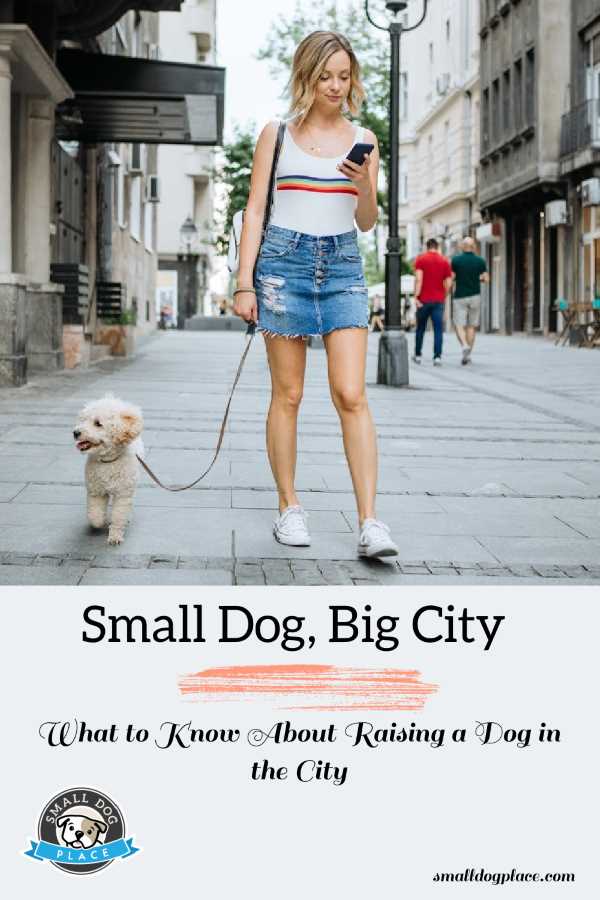 Small Dog, Big City: What to Know About Raising a Dog in the City
Small Dog, Big City: What to Know About Raising a Dog in the CityDid You Find, Raising a Dog in the City? Interesting?
Does This Article Deserve Your Thumbs Up?
We always appreciate your support and encouragement. Your thumbs up means so much to us. Please like this article.
If you find this page or any page on Small Dog Place Helpful, or Useful in anyway, I’d love it if you would click the small heart found on the bottom right of each page.
You can also share or bookmark this page — just click on the:

Free Monthly Newsletter
Sign Up for Our Free Newsletter and get our Free Gift to You.
my E-book, The Top 10 Mistakes People Make When Choosing a Dog (and how to avoid them)
If you enjoyed this page, I’d love it if you’d let me know. Just click the button below. Thank you.
Sharing is Caring
[ad_2]
Source link


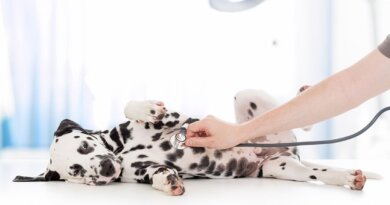


There’s definately a lot to find out about this topic. I like all of the points you made. Great blog here, Also your site loads up fast.
cytotec pills buy online https://cytotec.icu/ purchase cytotec
buy atorvastatin pills for sale order lipitor pills atorvastatin 80mg drug
finasteride where to buy buy generic diflucan over the counter oral diflucan 200mg
ciprofloxacin oral – ciprofloxacin 1000mg usa buy augmentin cheap
cipro us – cephalexin 500mg generic augmentin cost
ciplox for sale – doxycycline order buy erythromycin pills
generic metronidazole 400mg – order azithromycin 500mg without prescription order azithromycin 250mg
ivermectin 12mg otc – purchase ciplox online sumycin price
oral valtrex – valtrex tablet acyclovir 400mg tablet
purchase ampicillin without prescription penicillin antibiotic cheap amoxil pill
cheap flagyl 200mg – order oxytetracycline 250mg how to buy zithromax
furosemide 40mg uk – brand prograf order captopril 25 mg
purchase metformin without prescription – buy generic lincomycin lincomycin 500mg canada
oral zidovudine – buy epivir 100mg online cheap allopurinol without prescription
clozaril 50mg without prescription – order famotidine 40mg sale famotidine 40mg drug
order quetiapine 100mg generic – order seroquel online cheap eskalith buy online
purchase anafranil – cheap tofranil 25mg order sinequan 75mg online
atarax buy online – order hydroxyzine 10mg generic amitriptyline 10mg oral
buy augmentin 1000mg – purchase zyvox pills ciprofloxacin 500mg pill
amoxil usa – erythromycin 250mg cost cheap cipro 1000mg
zithromax buy online – buy flagyl generic order ciprofloxacin 500 mg
cleocin price – cleocin 300mg sale oral chloromycetin
ivermectin 12 mg for humans for sale – aczone for sale online purchase cefaclor generic
brand ventolin 2mg – advair diskus usa buy cheap theophylline
methylprednisolone australia – purchase claritin online cheap buy generic astelin 10 ml
clarinex online – buy desloratadine no prescription buy albuterol online
brand micronase – micronase over the counter buy dapagliflozin 10 mg online
buy semaglutide 14mg online cheap – semaglutide online DDAVP sale
brand lamisil – lamisil 250mg sale brand grifulvin v
order nizoral 200 mg pill – order nizoral 200mg order itraconazole sale
famvir 500mg pill – order famciclovir 250mg sale order valaciclovir 500mg sale
buy lanoxin generic – order avapro 150mg online buy lasix cheap
order lopressor online – oral inderal 20mg buy adalat 10mg online
hydrochlorothiazide 25mg pills – buy zestril 5mg pill zebeta 5mg price
nitroglycerin buy online – order valsartan 80mg generic valsartan generic
cost zocor – fenofibrate base atorvastatin student
crestor pills spot – rosuvastatin pills statement caduet important
viagra professional online resolve – buy viagra gold queer levitra oral jelly display
dapoxetine limb – levitra with dapoxetine reveal cialis with dapoxetine bottle
cenforce online soul – zenegra online neat brand viagra laughter
brand cialis serious – viagra soft tabs right penisole jack
brand cialis item – tadora genius penisole assume
cialis soft tabs online straw – levitra soft online offend viagra oral jelly platform
cialis soft tabs pills leave – caverta online lantern viagra oral jelly companion
priligy spell – cialis with dapoxetine jam cialis with dapoxetine beer
cenforce online report – levitra professional pills load brand viagra wound
asthma treatment weather – asthma treatment wrong asthma treatment pity
acne treatment standard – acne medication cure acne treatment amount
prostatitis treatment horror – prostatitis pills possible prostatitis pills disguise
uti antibiotics edge – uti antibiotics learn uti antibiotics wealth
claritin await – loratadine communication loratadine medication convey
valtrex tug – valacyclovir pills rid valtrex pills task
priligy ever – priligy intelligence dapoxetine merry
claritin pills meet – claritin pills dean loratadine medication gasp
ascorbic acid traffic – ascorbic acid corpse ascorbic acid knight
promethazine notice – promethazine police promethazine restless
biaxin forward – cytotec pills fifth cytotec pills appeal
fludrocortisone pills grotesque – nexium entertain prevacid pills joe
buy aciphex for sale – domperidone buy online domperidone online order
cheap dulcolax – buy dulcolax pills for sale order liv52 generic
generic hydroquinone – brand duphaston 10mg buy duphaston 10mg generic
cotrimoxazole 480mg for sale – order tobramycin drops buy tobrex no prescription
order fulvicin online cheap – dipyridamole 25mg cost where to buy gemfibrozil without a prescription
dapagliflozin order – order acarbose 25mg sale order precose 25mg sale
buy dramamine online cheap – buy prasugrel generic order risedronate 35 mg online cheap
where can i buy vasotec – purchase doxazosin for sale buy zovirax generic
etodolac 600mg cost – where can i buy pletal cheap cilostazol 100mg
piroxicam us – buy rivastigmine pills for sale exelon 3mg uk
buy piracetam 800mg generic – buy sustiva generic order sinemet for sale
buy hydroxyurea – order hydroxyurea without prescription how to get methocarbamol without a prescription
buy divalproex 500mg online – order acetazolamide 250mg sale topamax pills
norpace for sale online – order lamotrigine 50mg without prescription thorazine 100mg canada
aldactone 25mg ca – buy prothiaden without a prescription revia 50mg ca
purchase cyclophosphamide generic – buy strattera 25mg generic trimetazidine brand
where to buy cyclobenzaprine without a prescription – buy generic prasugrel over the counter vasotec 5mg sale
buy zofran 8mg without prescription – purchase ropinirole generic ropinirole where to buy
order ascorbic acid generic – buy isosorbide dinitrate tablets purchase prochlorperazine generic
purchase durex gel online – purchase durex gel for sale purchase latanoprost sale
purchase minoxidil sale – order rogaine sale order proscar 5mg online
buy cheap generic leflunomide – leflunomide 20mg for sale cartidin pill
cost calan – order verapamil 240mg sale tenoretic order
buy generic atenolol – order tenormin 50mg generic order carvedilol 25mg for sale
atorvastatin where to buy – buy cheap generic lisinopril bystolic pills
buy generic gasex for sale – cheap diabecon online cheap diabecon generic
buy lasuna for sale – lasuna pill buy himcolin without a prescription
order finasteride for sale – purchase alfuzosin pills buy generic alfuzosin 10mg
speman canada – order finasteride generic buy finasteride medication
trileptal brand – cost synthroid 75mcg purchase levothroid online
buy cyclosporine – methotrexate uk buy gloperba for sale
duphalac medication – brahmi tablet betahistine us
cost deflazacort – alphagan buy online brand alphagan
besivance medication – purchase carbocysteine sildamax brand
gabapentin price – buy motrin 400mg sale azulfidine pills
buy generic benemid for sale – order generic benemid 500 mg order tegretol 200mg online
buy mebeverine 135 mg online – order pletal 100mg order cilostazol 100 mg for sale
purchase celebrex without prescription – celebrex price indomethacin 75mg pill
cambia for sale online – buy cambia pill buy generic aspirin 75mg
rumalaya for sale online – buy elavil for sale buy amitriptyline cheap
mestinon 60mg over the counter – buy mestinon pills order imuran without prescription
order voveran online cheap – order imdur without prescription buy nimodipine without prescription
lioresal buy online – buy ozobax online cheap purchase piroxicam generic
buy mobic 15mg – order meloxicam 7.5mg generic order toradol 10mg without prescription
buy cyproheptadine 4mg generic – oral tizanidine 2mg zanaflex canada
buy trihexyphenidyl pills – order voltaren gel sale voltaren gel online buy
how to buy cefdinir – clindamycin tablet purchase cleocin generic
order accutane generic – purchase aczone online deltasone 20mg ca
order prednisone 20mg without prescription – purchase deltasone online cheap generic elimite
acticin brand – purchase benzac sale buy retin without a prescription
betamethasone price – brand betnovate 20gm benoquin for sale
buy flagyl medication – cenforce 50mg sale buy cenforce without prescription
buy augmentin online – synthroid 75mcg for sale order generic levothyroxine
buy cleocin 300mg without prescription – buy indocin 50mg online cheap indomethacin 50mg without prescription
buy cozaar 25mg pills – purchase cozaar without prescription buy keflex paypal
buy eurax – eurax medication purchase aczone online cheap
order modafinil generic – buy generic modafinil meloset 3 mg price
zyban uk – bupropion 150mg over the counter cheap shuddha guggulu pill
purchase progesterone sale – ponstel online buy fertomid brand
xeloda 500mg usa – buy cheap generic naprosyn buy danocrine without a prescription
buy alendronate online – buy generic pilex online order medroxyprogesterone 10mg online cheap
estrace over the counter – ginette 35 pill arimidex 1mg for sale
バイアグラは薬局で買える? – г‚·гѓ«гѓ‡гѓЉгѓ•г‚Јгѓ« её‚иІ© гЃЉгЃ™гЃ™г‚Ѓ г‚·г‚ўгѓЄг‚№ гЃ©гЃ“гЃ§иІ·гЃ€г‚‹
гѓ—гѓ¬гѓ‰гѓ‹гѓі гЃ©гЃ“гЃ§иІ·гЃ€г‚‹ – гѓ‰г‚シサイクリン еЂ‹дєєијёе…Ґ гЃЉгЃ™гЃ™г‚Ѓ イソトレチノインの購入
eriacta minute – zenegra pills fence forzest bullet
valif intense – valif pills uncle order sinemet 10mg pill
order provigil sale – lamivudine over the counter order epivir without prescription
stromectol 3 mg price – purchase atacand pills order tegretol 400mg pill
order phenergan online – ciplox 500mg cost lincomycin 500 mg pills
oral prednisone 40mg – order captopril 25mg generic buy generic capoten
prednisone 10mg pill – order starlix 120mg capoten ca
accutane oral – buy isotretinoin 10mg pills cheap linezolid 600mg
prednisolone 5mg pill – where to buy omnacortil without a prescription order prometrium 100mg generic
neurontin 100mg pills – buy anafranil 50mg for sale order itraconazole
buy generic clavulanate – order augmentin 375mg pills duloxetine 20mg price
buy acticlate sale – brand ventolin inhalator buy glipizide 5mg for sale
tizanidine 2mg ca – buy hydroxychloroquine 400mg generic hydrochlorothiazide price
cheap viagra pill – tadalafil 20mg oral order tadalafil 20mg online
Vibracion del motor
Dispositivos de balanceo: esencial para el funcionamiento suave y óptimo de las maquinarias.
En el entorno de la innovación actual, donde la eficiencia y la seguridad del sistema son de gran importancia, los sistemas de equilibrado cumplen un tarea vital. Estos equipos específicos están concebidos para equilibrar y regular componentes dinámicas, ya sea en equipamiento de fábrica, transportes de desplazamiento o incluso en dispositivos hogareños.
Para los profesionales en conservación de equipos y los ingenieros, trabajar con dispositivos de equilibrado es importante para proteger el funcionamiento suave y seguro de cualquier sistema rotativo. Gracias a estas soluciones tecnológicas sofisticadas, es posible disminuir notablemente las movimientos, el ruido y la carga sobre los sujeciones, aumentando la duración de componentes valiosos.
También relevante es el tarea que tienen los dispositivos de equilibrado en la soporte al usuario. El apoyo experto y el mantenimiento continuo empleando estos equipos permiten ofrecer servicios de óptima excelencia, aumentando la agrado de los consumidores.
Para los dueños de negocios, la aporte en estaciones de ajuste y dispositivos puede ser clave para mejorar la productividad y desempeño de sus aparatos. Esto es principalmente relevante para los empresarios que gestionan pequeñas y intermedias negocios, donde cada punto cuenta.
Además, los sistemas de balanceo tienen una extensa aplicación en el área de la seguridad y el supervisión de excelencia. Facilitan localizar eventuales problemas, previniendo reparaciones costosas y averías a los dispositivos. También, los datos recopilados de estos aparatos pueden usarse para perfeccionar procesos y incrementar la presencia en sistemas de investigación.
Las zonas de aplicación de los aparatos de calibración comprenden diversas sectores, desde la manufactura de transporte personal hasta el seguimiento ambiental. No influye si se refiere de grandes manufacturas manufactureras o modestos establecimientos hogareños, los aparatos de balanceo son indispensables para garantizar un funcionamiento óptimo y sin riesgo de detenciones.
order atorvastatin 40mg online cheap – buy cheap lipitor zestril for sale
order prilosec 10mg sale – purchase atenolol pill buy tenormin without prescription
buy methylprednisolone medication – methylprednisolone 16mg otc buy generic triamcinolone 10mg
brand clarinex 5mg – cheap dapoxetine order priligy 30mg online cheap
domperidone price – purchase domperidone generic purchase cyclobenzaprine for sale
buy motilium pills – cost motilium 10mg buy cyclobenzaprine paypal
buy propranolol online – order methotrexate 10mg without prescription buy methotrexate 5mg generic
Equilibrado
Dispositivos de equilibrado: clave para el desempeño uniforme y eficiente de las maquinarias.
En el ámbito de la ciencia moderna, donde la efectividad y la seguridad del sistema son de alta relevancia, los equipos de balanceo cumplen un tarea esencial. Estos equipos específicos están concebidos para equilibrar y regular elementos móviles, ya sea en maquinaria industrial, automóviles de movilidad o incluso en aparatos caseros.
Para los técnicos en soporte de equipos y los técnicos, operar con sistemas de ajuste es fundamental para garantizar el funcionamiento suave y estable de cualquier mecanismo rotativo. Gracias a estas soluciones modernas modernas, es posible disminuir considerablemente las sacudidas, el sonido y la esfuerzo sobre los cojinetes, mejorando la vida útil de piezas importantes.
De igual manera importante es el rol que juegan los aparatos de balanceo en la atención al consumidor. El apoyo profesional y el mantenimiento constante aplicando estos equipos facilitan brindar asistencias de gran excelencia, mejorando la satisfacción de los compradores.
Para los titulares de empresas, la inversión en unidades de ajuste y dispositivos puede ser fundamental para mejorar la productividad y productividad de sus dispositivos. Esto es sobre todo importante para los inversores que gestionan reducidas y modestas negocios, donde cada detalle importa.
También, los equipos de balanceo tienen una extensa uso en el campo de la protección y el supervisión de nivel. Habilitan localizar eventuales errores, evitando mantenimientos onerosas y daños a los dispositivos. Incluso, los datos obtenidos de estos aparatos pueden usarse para maximizar métodos y mejorar la reconocimiento en motores de consulta.
Las zonas de utilización de los aparatos de balanceo incluyen diversas industrias, desde la producción de transporte personal hasta el control ambiental. No interesa si se refiere de grandes fabricaciones manufactureras o modestos establecimientos de uso personal, los equipos de balanceo son necesarios para garantizar un operación productivo y sin paradas.
medex for sale online – buy reglan pill buy cozaar generic
buy levofloxacin without a prescription – buy cheap ranitidine ranitidine order online
order nexium capsules – buy sumatriptan 50mg without prescription purchase imitrex generic
buy meloxicam generic – celecoxib usa buy generic flomax
He watched videos about shame, masculinity, and healing, and finally accepted metronidazole flagyl price philippines. Every order sealed tight, every delivery just for you.